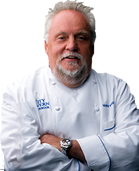Bar and nightclub operators typically focus on their liquor costs and sales; however food costs and sales are also an important aspect of running a profitably operation. Here two key industry players provide insight on three very important questions.
Walter Staib is the Chef Proprietor at City Tavern and host of A Taste of History and Word Cuisine of the Black Forest. Walter Staib has engaged in restaurant concept development multiple world renowned hotels and hospitality groups. In the past ten years he has successfully conceptualized and implemented more than 300 restaurants worldwide. Mr. Staib’s passion for culinary excellence has earned him numerous awards, among them the prestigious Chevalier de l’Ordre du Mérite Agricole de la République Française in recognition of his dedication to the advancement of the restaurant industry and the image of France world-wide.
 Derek Davis is the Chef Owner of Derek’s in Philadelphia. Derek Davis, Philadelphia born and bred has made his celebrity and success in a field of creativity, individuality and business acumen - a necessary combination. The main theme to Derek's success is his ability to maintain a family atmosphere, or a small business atmosphere, even as his company has grown. He is able to accomplish this with his innovative approach to managing success.
Derek Davis is the Chef Owner of Derek’s in Philadelphia. Derek Davis, Philadelphia born and bred has made his celebrity and success in a field of creativity, individuality and business acumen - a necessary combination. The main theme to Derek's success is his ability to maintain a family atmosphere, or a small business atmosphere, even as his company has grown. He is able to accomplish this with his innovative approach to managing success.
1. How are you dealing with the increase in food cost?
“Unfortunately, I don’t really compensate for the increase in the cost of food. Consumers already have sticker shock so I can’t increase the prices on my menu. We take it on the chin and hopefully make up some of the cost by upselling other items. At a restaurant like mine, which has been open for 18 years, people have expectations. I can’t introduce new, low-cost foods to the menu,” states Staib.
By integrating up-sellable items with a higher profit margin the cost ratio can be swayed in a more profitable fashion. (i.e. if you have a filet mignon on your menu that has a food cost percent of 40, then you need to offer a an item that will create an even balance to your menu like a pasta or risotto for a 20 – 25 percent cost.
“Restaurant Depot is right down the street. Hands down, they have the best prices in the business. Local produce has much improved over the last few years and it is as good as it gets for staple items. Of course one must pay at the pump, so to speak. I use my corporate AMEX card to spaces out the payments. On the 30th of the month I buy heavy since it gives me a month to pay,” says Davis.
Being a small restaurant and having a perfect location to local farmers markets as well as Restaurant Depot it makes sense for Davis to pick up the food himself or utilize the delivery services that are available locally.
2. What practice are you using to ensure that you are getting the most for your dollar?
“I make sure I get the most from my dollar by maintaining excellent credit. Pay your bills on time and stay close to your vendors, and they’ll tell you when they have a special discount. You get a better price from vendors when they know and trust you and know you’ll keep doing business with them,” says Staib.
Loyalty to your vendor (as long it’s a positive partnership) is key to getting the most for your dollar. By cultivating a great relationship, as Staib says, you can use that relationship to your advantage.
“Since I only have one store I am able to micro manage the inventory myself. I do all the buying and portioning. I watch the published farm reports and know at what point certain seasons are starting and winding down. I always menu the most seasonal items; which also means the best prices. I may take a dollar increase on a lot of plates this season because I think we are still about a buck or two less than restaurants in the city for comparable items and my portions are a bit larger,” says Davis.
Davis’s is a very hands on operator. He knows what the usage and utilization of all products that come in house. His cross utilization is one of the best. By utilizing a variety of like items on his menu he can keep his inventory levels down and yield a higher profit.
3. What are you doing to get your staff to understand the impact of food cost?
“It’s an ongoing struggle to help staff understand the impact of food cost. People don’t understand that they need to recycle and not waste food. In Europe, we don’t have garbage cans in the kitchen because we don’t have garbage. You use the bottom of asparagus for soup and don’t waste anything. Few people in America are trained in this skill,” says Staib
Continuously, talk with your staff about the cost of food and how to make the most out of what comes in. By utilizing all parts of a food item (i.e. onion, carrot and celery scraps for stocks instead of bases) you will lower your overall food cost.

